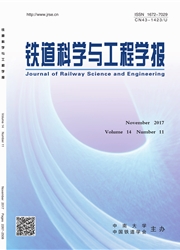

 中文摘要:
中文摘要:
以某四跨一联简支转连续刚构桥(跨径(38+40+40+38)m)为例,采用Midas-civil建立连续刚构桥全桥分析模型,对主梁分别采用不同存梁期预制梁的连续刚构桥,计算其桥墩和主梁的相关变形及内力。研究结果表明:预制梁混凝土早期自收缩发展较快,同时由于收缩徐变效应与混凝土龄期直接相关,存梁期对结构内力和变形影响较大,建议施工中采用存梁期大于90d预制梁。由于收缩徐变作用,与30d存梁期相比,90d和180d存梁期成桥墩顶内力分别减小11.8%和20.2%,成桥跨中挠度分别减少19.2%和31%。在主梁施工控制时必须考虑实际存梁期来调整结构线形。分析结构体系转换后主梁内力及变形可知,主梁收缩徐变内力重分布及变形基本在3a内完成,后期变化逐步平稳,但边墩受收缩徐变影响时间相对较长,验证了本桥型边墩施工顺序及采用柔性设计的合理性。
 英文摘要:
英文摘要:
A simply-supported to continuous rigid frame bridge with its four spans(38+40+40+38)m was used asa research object.The software Midas-civi was used to set up finite element model for whole bridge.The bridgewith different beam ages at erection were modeled respectively.The internal force and deformation of beam andpiers were studied considering the concrete long-term shrinkage and creep effect.The results show that,theautogenous shrinkage of concrete reacts rapidly in the beginning.Meanwhile,the shrinkage and creep are closelyrelated with time parameter.The age at erection has much influence on the force redistribution and deformation ofthe beam.The precast beams with age at erection more than90days are recommended to be used in theconstruction.Compared with the30days stored precast beam,the forces of the pier-top beam with90and180days storage time decrease11.8%and20.2%respectively.The stored time has a negligible effect on the shrinkageand creep.The real stored time must be taken into consideration when adjusting the pre-camber degree.Resultsfrom analyses show that the shrinkage and creep of the beam are nearly complete in the first three years after theconstruction finished while the side piers have a relative longer influence time,this verifies the design andconstuction of side-piers are rational.
 同期刊论文项目
同期刊论文项目
 同项目期刊论文
同项目期刊论文
 期刊信息
期刊信息
